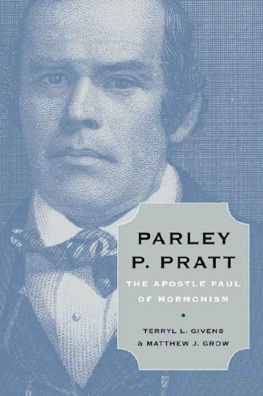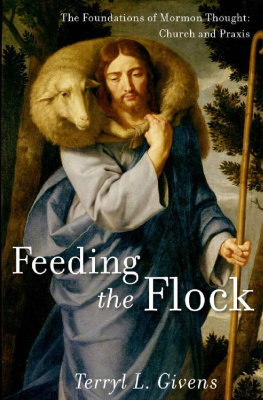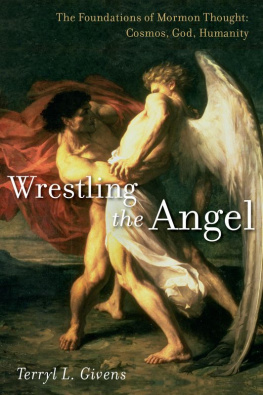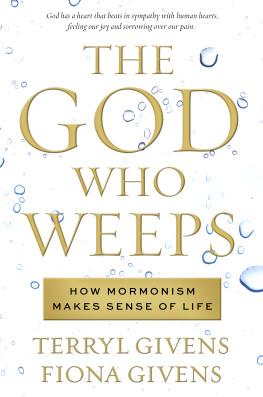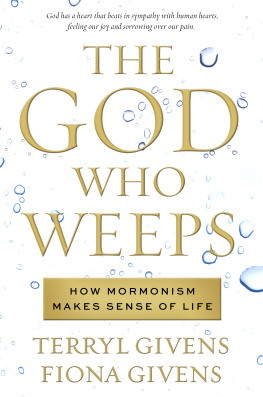Parley P. Pratt
The Apostle Paul
of Mormonism

TERRYL L. GIVENS
MATTHEW J. GROW


Oxford University Press, Inc., publishes works that further
Oxford Universitys objective of excellence
in research, scholarship, and education.
Oxford New York
Auckland Cape Town Dar es Salaam Hong Kong Karachi
Kuala Lumpur Madrid Melbourne Mexico City Nairobi
New Delhi Shanghai Taipei Toronto
With offies in
Argentina Austria Brazil Chile Czech Republic France Greece
Guatemala Hungary Italy Japan Poland Portugal Singapore
South Korea Switzerland Thailand Turkey Ukraine Vietnam
Copyright 2011 by Oxford University Press, Inc.
Published by Oxford University Press, Inc.
198 Madison Avenue, New York, New York 10016
www.oup.com
Oxford is a registered trademark of Oxford University Press
All rights reserved. No part of this publication may be reproduced,
stored in a retrieval system, or transmitted, in any form or by any means,
electronic, mechanical, photocopying, recording, or otherwise,
without the prior permission of Oxford University Press.
Library of Congress Cataloging-in-Publication Data
Givens, Terryl.
Parley P. Pratt : The Apostle Paul of Mormonism / Terryl L. Givens, Matthew J. Grow.
p. cm.
Includes bibliographical references and index.
ISBN 978-0-19-537573-2
1. Pratt, Parley P. (Parley Parker), 18071857. 2. Church of Jesus Christ of Latter-day
SaintsApostlesBiography. 3. Mormon ChurchApostlesBiography. 4. Church of Jesus Christ
of Latter-day SaintsHistory. 5. Mormon ChurchHistory. I. Grow, Matthew J. author. II. Title.
BX8695.P7G58 2011 289.3092dc22
[B]
2011005099
1 3 5 7 9 8 6 4 2
Printed in the United States of America
on acid-free paper
To Sylvia I. Givensmore the pillar than she ever realized,
and
Robert J. Growdad, champion, friend
Contents
Acknowledgments
SEVERAL SCHOLARS HAVE been generous in reading drafts, sharing research, and providing feedback and suggestions throughout the writing process. We owe a considerable debt to R. Steven Pratt, who spent years collecting and annotating Parley P. Pratts letters and materials, greatly aiding our work by his efforts and generosity. Financial support was provided by the Charles Redd Center for Western Studies and the College of Liberal Arts of the University of Southern Indiana. Several excellent historians of Mormonism and American religion reviewed early versions of this book, including David Whittaker, Steven Harper, Patrick Mason, John Turner, and Benjamin Parks. Glenn Rowe, Christopher Blythe, Brett Dowdle, Mauri Pratt, and Rachael Givens tracked down difficult sources and provided other research assistance. Jayne Fife graciously shared her own manuscript on Mary Ann Frost Pratt and responded to ours as well. LaJean Purcell Carruths meticulous transcriptions of Pratt sermons from nineteenth-century shorthand added greatly to our source material, as did typescripts provided by Dorsey Ford. Robert and Linda Grow read the manuscript with careful attention to detail and readability. Our wives, Fiona Givens and Alyssa Grow, gave their usual criticismspainfully perceptive and typically invaluable. We are especially grateful to Cynthia Read at Oxford, friend and editor extraordinaire.
Parley P. Pratt

FIGURE 1.1 Early undated photograph of Parley P. Pratt. Courtesy Utah State Historical Society.
Introduction
Earth ought to be full of prophets and heaven and earth full of angels.
PARLEY P. PRATT , sermon, 10 July 1853
ON A SPRING day in 1853, a forty-six-year-old Mormon apostle sat in his modest home just outside Temple Square in Salt Lake City to respond to a request from a long-lost friend from his youth for a sketch of his life. Reflecting upon his experiences, Parley P. Pratt mused that such a history would overload the mail and would appear far more strange to you than the thousand volumes of Modern Fiction. Against the background of their shared boyhood in the backwoods of New York, Pratts subsequent life appeared improbable, even fantastic. Since that time, he had traveled widely throughout the United States and Canada, led Mormon pioneer companies past the moving masses of wild Buffalo on the boundless, treeless plains to Utah, preached in San Francisco during the Gold Rush, crossed the Atlantic Ocean six times, and eaten figs from the tree in Chile. His life had been one of extremes, of poverty and riches, peace and war, sublime joys and devastating sorrows.
Controversy had perennially stalked him, Pratt continued, as he had been received almost as an Angel by thousands and counted an Imposter by tens of thousands. Fifteen years previously in Missouri, he had lain months in gloomy dungeons, and been loaded with chains, though he had been visited there by visions of Angels and Spirits, and been delivered by miracles. As a defender of Mormonism, Pratt had publicly debated priests, learned men and Infidels, stood before senators and Governors, and had edited periodicals and written and published books. In his private life, Pratt would marry a dozen times and father thirty children. In short, he wrote, I have been a farmer, a servant, a fisher, a digger, a beggar, a preacher, an author, an editor, a senator, a traveler, a merchant, an elder and an Apostle of Jesus Christ. Pratt exclaimed, Is not truth stranger than fiction!!!
Pratts well-honed literary instincts were correct; the narrative of his life could have formed the basis of a page-turning novel. By 1853, he had already become, after Joseph Smith and Brigham Young, the most influential figure in shaping early Mormon history, culture, and theology. Pratt exerted that influence across an astounding spectrum, excelling as a missionary, explorer, hymnist, pamphleteer, autobiographer, historian, and theologian. The final four years of his life only solidified his place as one of the most engaging, colorful, and powerful figures in early Mormonism. In 1857, to the unrestrained cheers of the national media and the laments of the Latter-day Saints, Pratt was murdered in Arkansas by the estranged husband of his twelfth wife.
Born to a hardscrabble family in New York in 1807, Pratt struck out in the late 1820s for the frontier of northern Ohio, where he converted to the religious message of the Campbellites, modeled on the primitive Christian Church of the New Testament. Inspired by his newfound faith, Pratt became a freelance minister during the chaotic years of the Second Great Awakening, but an encounter with the Book of Mormon in the fall of 1830 changed his trajectory. By converting to Mormonism, Pratt added doctrines of priesthood authority to the primitivism and millennialism of the Campbellites. The Book of Mormon fired his religious imagination, both as a harbinger of millennial events and for proclaiming American Indians to be the descendants in part of an Israelite civilization. He joined the infant Mormon movement in September 1830, six months after its formal founding. Soon after his baptism, Joseph Smith, the youthful Mormon prophet, appointed him as one of four missionaries to the Lamanites, the Book of Mormon people whose descendants early Mormons viewed as contemporary American Indians, in Missouri. Pratts decision to take his fellow missionaries to visit his former religious mentor, Campbellite Sidney Rigdon, in Kirtland, Ohio, altered Mormon history, as hundreds of conversions followed and shifted the Mormon center of gravity from New York to Ohio. Soon Smith announced a revelation proclaiming a gathering of his followers in that area.

